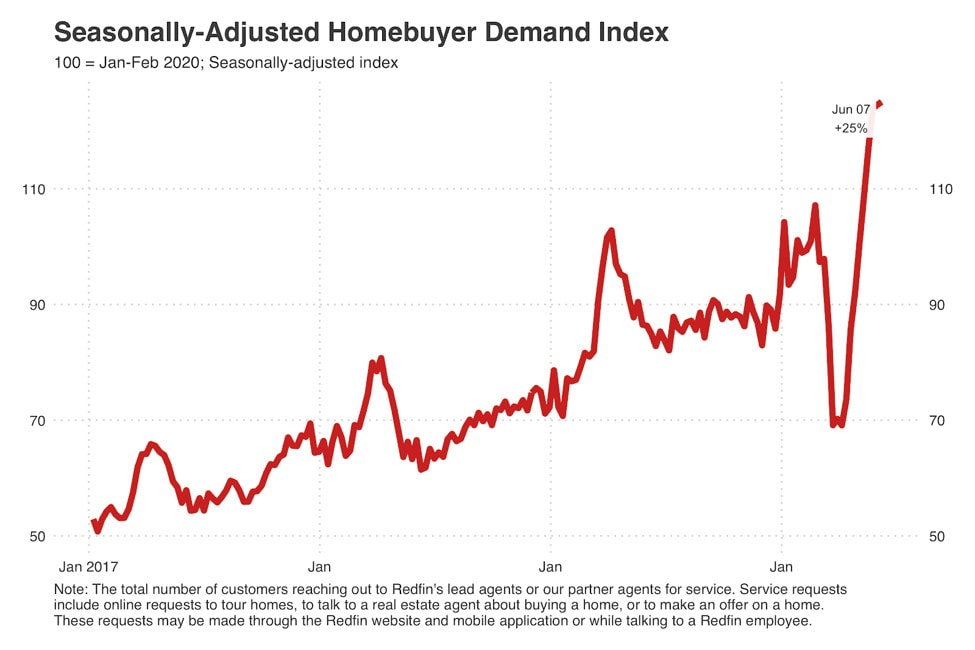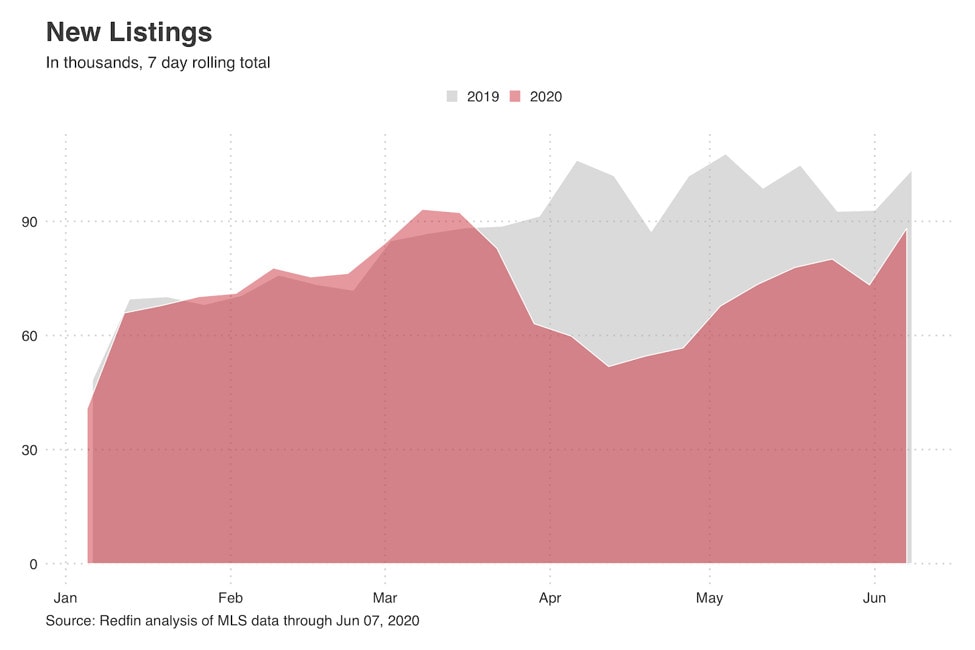It seems that nothing can deter homebuyers. Seasonally adjusted demand for the week of June 1 – June 7 is now 25% higher than it was pre-pandemic in January and February, marking the eighth straight week of rising demand.

Our abiding concern in May was about the number of homes for sale, but that’s improving too. After falling to 21% below last year’s level the week of May 25 – 31, new listings last week continued their recovery; last week’s new listings were 15% below last year’s level.

Listings accepting an offer improved as well. Two weeks ago, this number was down 11% year-over-year, but for the week of June 1 – June 7 it was 9%. With demand surging and supply recovering, we expect sales to strengthen; mortgage purchase applications were up 7% year-over-year in the last week of May and up even more, 13%, in the first week of June.
Agents from Seattle to LA to Philadelphia have been surprised that protests didn’t deter more buyers. “It has been a speed bump,” said Alec Traub, an LA-based team manager for Redfin. Hazel Shakur, Redfin Maryland agent, reports that “between the virus and now the protests, folks are not batting an eyelash.” What’s driving demand is low rates and, now, easing credit. According to Sarah Martin, a Redfin mortgage advisor in Washington DC, “credit has pretty much loosened up except for self-employed borrowers.”
And sellers, always more careful than buyers, are finally responding to increased demand. “A lot of what I’m listing are not new clients, but people I’ve met with over the past few weeks and months,” said Seattle Redfin Agent David Palmer. “I’ll be bringing on double-digit listings in the month of June and expect the same for July. Those people who were looking to get top dollar and wanted to wait to list until they could get the most buyer attention, they can definitely get that now.”
It’s also easier for buyers than sellers to accept the health risks of touring. “We’ve had a lot of clients who are going to list with us but they’re just not ready yet,” said Mr. Traub, the LA team manager. “Especially when you live in your house, it’s more difficult to let an open-ended number of people walk through until the home is sold. When you’re a buyer, you can control the number of listings you see in-person. I think a lot of people still don’t feel comfortable with that and what that means for their own health.” Adds Charles Davies, a Redfin agent in Philly, “If it’s vacant, I can get those listings all day long.”
Until supply catches up to demand, prices will rise. For the week of June 1 – 7, year-over-year growth in asking prices was up 9.9%, compared to 7.9% the week before, and 3.9% in January and February. Sales prices for the first week of June are up 3.1% year-over-year, an improvement from 1.3% in May, when offers from late March and April were still closing. The percentage of newly listed homes accepting an offer within 14 days of their debut increased from 42% in May to 47% in the first week of June.
The major theme of our conversations with agents across the country this past week has been about bidding wars. “It’s just bananas, with so few listings and so many buyers,” said Ms. Shakur, the Redfin agent in Maryland. “Having lived through the 2008 bubble, I just want to be cautious. Maybe it’s nowhere near the same size as it was in ’08, and maybe it’ll turn out not to have been a bubble at all. But buyers are desperate. If a property is in a desirable neighborhood, buyers will overpay. Bidding wars, escalations, no inspections, agreement to pay over appraised value, all of that’s becoming the norm.” Adds Mr. Palmer, the Redfin agent in Seattle. “Anything I’m pricing correctly right now is flying off the shelf.”
No one knows for sure how long this will keep up, but very tight credit in recent months has at least limited housing speculation; price increases have been the result of record-low mortgage rates and inventory. “One thing I’ve noticed on my listings are our seller dashboards,” Mr. Palmer said. The seller dashboard shows Redfin listing clients and their agents how much online traffic a listing is getting, and how digital ad campaigns for that listing are performing. “The views are up definitely for what I would normally see for a week’s worth of views compared to this time last year. Usually 1,000 – 1,500 views would be a solid week for your first week. I’m having listings hit that on the first day.”
Online interest in listings now takes many forms. As shelter-in-place rules subside in parts of the country, much of the demand for virtual showings is from relocating homebuyers who want to avoid a long drive or a flight to tour a home. Fifteen percent of tours are happening via video-chat rather than in person. This is half of its April peak, but still 30 times higher than it was pre-pandemic.
The popularity of three-dimensional scans has been even more durable, with views of these scans on Redfin.com increasing 42% from April to May. In markets like Orange County and Seattle, a quarter of new listings include a scan, and we now believe this will be the most popular way to virtualize a showing, with buyers preferring to move through the home at their own pace, whenever they want.
Many of these relocating buyers are pursuing the suburbs, or smaller, more affordable cities. “It’s odd, because I’ve got two different sellers moving to Oklahoma, both for jobs,” said Ms. Shakur, the Redfin agent from Maryland. “That big migration we’re all expecting, it’s beginning to happen. People are now moving more to the interior of the country. I also have a lot of clients who are retiring and moving down south to more tax-favorable states.”
“I think some sellers are now at the point where they don’t want to be in the city anymore or keep paying high prices to stay here,” said Mr. Traub, one of Redfin’s LA team managers. “A lot of people relocate to LA for work, but now they realize they could go back home and their money would go further, especially when they can work remotely.”
It has been a point of debate within Redfin whether the movements of people we’re now seeing are mostly to the outlying areas of the same city, or to entirely different parts of the country. What we can be sure of now is that this latter group of cross-country movers is already increasing in size, albeit only modestly: in April and May of 2020, 27% of Redfin.com users searched outside their metropolitan area, compared to 25% in April and May of 2019.
We now speculate that the flexibility to work remotely, combined with low interest rates, will lead to higher levels of home ownership in the U.S., which have mostly been declining since 2004. “With interest rates so low, a lot of people want to buy who are currently renting in the city,” said Redfin Boston Agent Elynn Chen. “They want to go somewhere for more space.”
But even though demand is strong now, no one can say for sure what the long-term outlook is. The whole reason we’re reporting on demand every week instead of every month is because we have seen such a volatile real estate market. “A lot of jobs are not coming back,” said Mr. Palmer, the Redfin Seattle agent. “Would-be first-time buyers are gonna say screw it. They are just thinking about how to pay rent and survive. We have a lot of band-aids with unemployment insurance right now, but those aren’t going to last forever. Condos are tough [to sell] right now. The ball is going to drop and it will be interesting to see how it rolls down the hill.”

